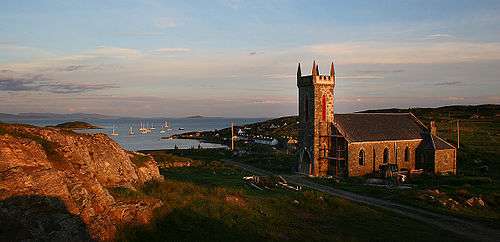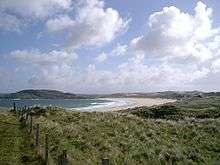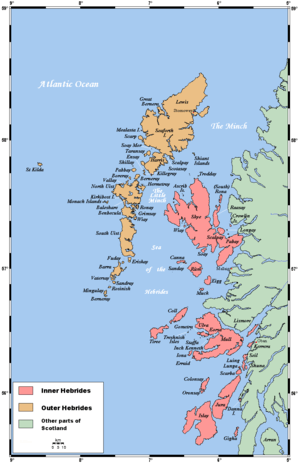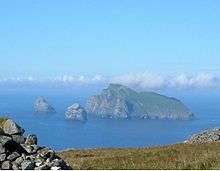Coll
| Gaelic name | Cola |
|---|---|
| Pronunciation | [kʰɔlˠ̪ə] |
| Meaning of name | Pre-Celtic and unclear |
| Location | |
 Coll Coll shown within Argyll and Bute | |
| OS grid reference | NM207584 |
| Physical geography | |
| Island group | Mull |
| Area | 7,685 hectares (29.7 sq mi)[1] |
| Area rank | 18 [2] |
| Highest elevation | Ben Hogh 106 metres (348 ft)[3] |
| Administration | |
| Sovereign state | United Kingdom |
| Country | Scotland |
| Council area | Argyll and Bute |
| Demographics | |
| Population | 195[4] |
| Population rank | 32= [2] |
| Pop. density | 2.5 people/km2[3][4] |
| Largest settlement |
Arinagour[1] |
| Designated | 31 March 1995 |
| References | [1][5] |

Coll (Scottish Gaelic: Cola)[6] is an island located west of Mull in the Inner Hebrides of Scotland. Coll is known for its sandy beaches, which rise to form large sand dunes, for its corncrakes, and for Breacachadh Castle. It is in the council area of Argyll and Bute.
Geography and geology
Coll is about 13 miles (20 km) long by 3 miles (5 km) wide and has a population of around 195. Coll's sandy beaches rise to form large sand dunes. The highest point on Coll is Ben Hogh in the mid west of the island, a ridge with two tops running NW/SE, which rises initially to a height of 104 metres (341 ft) with a triangulation pillar, and to 106 metres (348 ft) 450 metres (492 yd) to the southeast.[5]
Settlements
Arinagour (Scottish Gaelic: Àirigh nan Gobhar),[7] is the main settlement on the island located at the head of Loch Eatharna, on the east coast.[8] Other inhabited locations include:
- Acha (Scottish Gaelic: An t-Achadh),[9] a crofting settlement located 5 kilometres (3.1 mi) south-west of Arinagour.[10]
- Arileod (Scottish Gaelic: Àirigh Leòid),[7] located on the west coast; 7 kilometres (4.3 mi) south-west of Arinagour.[11]
- Arnabost (Scottish Gaelic: Àrnabost),[7] located 3 kilometres (1.9 mi) miles north-west of Arinagour. it is the junction for travel between Sorisdale, Clabhach and Arinagour.[12]
- Ballyhaugh (Scottish Gaelic: Baile Hogh),[13] located on the northern part of Hough Bay; 5 kilometres (3.1 mi) west of Arinagour.[14]
- Bousd (Scottish Gaelic: Babhsta),[15] located 7 kilometres (4.3 mi) north-east of Arinagour.[16]
- Clabhach (Scottish Gaelic: A' Chlabaich),[17] located on the north-west coast; 5 kilometres (3.1 mi) north-west of Arinagour.[18]
- Crossapol (Scottish Gaelic: Crosabol),[19] located on the south-west coast.[20]
- Totronald (Scottish Gaelic: Tobhta Raghnaill), located on the west coast 7 kilometres (4.3 mi) southwest of Arinagour.[21]
- Uig (Scottish Gaelic: Ùig),[22] located 1 kilometre (0.62 mi) north-east of the head of Loch Breachacha.[23]
Etymology
Coll is sometimes derived from Gaelic coll, 'hazel'.[24] However, this does not match the early recorded forms of the name.[25] The name of Coll is given as Colosus in the Life of St Columba by Adamnán, the seventh century abbot of Iona.[26] As /s/ between vowels had been lost in Celtic before Adamnán's time, Watson suggests that Colosus may represent a pre-Celtic name.[24] Richard Coates has proposed that the name may be related to Greek kolossós and may have referred to a humanoid standing stone located on the island, like those still seen on North Uist and Lewis.[27] As Kolossós is not originally a Greek word,[27] Coates suggests that the name could have been given to Coll at a time when the kolossói of Mediterranean culture were well-known, or named "by speakers of a language in which the ancestor of the word was the native term."[25] In Icelandic, the word kollur (Old Norse: kollr, Norwegian: koll or kolle) means "a rounded protrusion, such as a rounded mountaintop, or a tussock".
History
Coll was home to a branch of the Clan Maclean for 500 years, not all of which were peaceful. In 1583 the Macleans of Duart invaded their cousins on Coll with the intention of taking the island for themselves. A battle was fought at Totronald near Breacachadh Castle where the Coll clan overwhelmed the Duarts, chopped off their heads and threw them in the stream, which is still known as "the stream of the heads". The Macleans of Coll retained their baronial fief and Castle of Breacachadh until 1848 when Alexander Maclean of Coll emigrated to Natal, South Africa where he died unmarried.
In 1549 Dean Monro wrote of "Coll" that it was "ane mane fertile Ile inhabite and manurit, with an castell and ane paroch kirk in it, gude for fishing and fowlers, with ane utter fine Falcons nest in it".[28]
Coll, like other Hebridean islands, has several crannógs (artificial islands) located in some of its lochs. One such crannog is Dun Anlaimh, which is thought to date to at least the later Middle Ages. Local tradition states that the dun was the fortress of a Norse chieftain who was defeated in battle by the Macleans.
Breacachadh Castle on the south coast dates from the 15th century. It was restored by Nicholas Maclean-Bristol, founder of Project Trust.[29] An 18th-century mansion house stands nearby.
The population of Coll was much higher in the past. In the late 18th century there were about 1,000 people supported by agriculture and fishing.[1] During the Highland clearances of the 1830s and 1840s, half the population left, many of them moving to Australia, Canada or South Africa. The population at the time of the 2001 census was only 164 but by 2011 the island's population was 195 as recorded by the 2011 census an increase of nearly 19%.[4][30] During the same period Scottish island populations as a whole grew by 4% to 103,702.[31]

| Clan Maclean Clan Maclaine |
|---|
 |
| Branches |
|
| Lands |
| Castles |
| Septs |

Present day
Transport
There are only two main roads on Coll. The main hub of the island is the island's largest settlement—Arinagour. Just over a kilometer (0.7 miles) south of Arinagour is the Caledonian MacBrayne ferry terminal.[32] The ferry travels from Oban to Coll to Tiree; and a return trip from Tiree, to Coll, to Oban.[33][33] The ferry between Oban and Castlebay on Barra goes via Coll and Tiree once a week.
The airport on the island, (IATA: COL) is located between Uig and Arileod. Highland Airways who originally operated the route to Oban went into administration in 2010,[34] but a new operator, Hebridean Air Services now operates the route under a PSO with flights to Oban, Tiree and Colonsay. The aircraft used for the flights are a BN2 Islander (G-HEBS). Hebridean headquarters are at Cumbernauld Airport, North Lanarkshire.
Economy
In July 2012, HRH Princess Anne formally opened the Isle of Coll's new community centre, An Cridhe, and hostel, Coll Bunkhouse. Owned and managed by the community-led organisation Development Coll, the new facilities were built to provide much needed amenities on the island and a social hub for the local community. An Cridhe now hosts a series of annual events such as the Half Marathon, the Coll Show, a Basking Shark Festival, a Bird Festival, a Chamber Music Festival, as well as a range of music, comedy, theatre and dance throughout the year.
In December 2013 Coll secured 'dark skies' status, only the second location in Scotland to do so.[35] The island has no street lights and little other light pollution, allowing spectacular views of the night sky on clear nights. In winter the Northern Lights are often visible.[36]
The charity Project Trust, which organizes overseas volunteering and gap-years, has been based on the island since 1974.[37][38]
Wildlife
There is an extensive RSPB reserve towards the west end of the island.[39] One of the main attractions is the rare corncrake. Traditional local farming practices have helped this once common British bird survive.
In 2010, a colony of short-necked oil beetles was found on the island. The beetle, thought to be extinct in the UK, is now known only to occur in southern England and Coll. It is parasitic on ground-dwelling bees, and is also flightless, begging the question of how it arrived on the island. It does not appear to be found on neighbouring Tiree, possibly because of a difference in terrain. Modern farming methods had partly caused its demise elsewhere.[40]
In fiction
Mairi Hedderwick, the illustrator and author, used to live on Coll and has used the island as the setting for her Katie Morag series of children's books. In the books, Coll is known by the fictional name of the Isle of Struay.[41]
In Alexander McCall Smith's The Charming Quirks of Others the protagonist, Isabelle Dalhousie, discusses Coll as a place for a honeymoon.[42]
See also
- List of Sites of Special Scientific Interest in Mull, Coll and Tiree
- Cairns of Coll
- Religion of the Yellow Stick
Notes
- 1 2 3 4 Haswell-Smith (2004) pp. 118-22
- 1 2 Area and population ranks: there are c. 300 islands over 20 ha in extent and 93 permanently inhabited islands were listed in the 2011 census.
- 1 2 Haswell-Smith (2004) p. 118
- 1 2 3 National Records of Scotland (15 August 2013) (pdf) Statistical Bulletin: 2011 Census: First Results on Population and Household Estimates for Scotland - Release 1C (Part Two). "Appendix 2: Population and households on Scotland’s inhabited islands". Retrieved 17 August 2013.
- 1 2 Ordnance Survey. Get-a-map (Map). 1:25,000. Leisure. Ordinance Survey. Retrieved 21 August 2013.
- ↑ Mac an Tàilleir (2003) p. 31
- 1 2 3 Mac an Tàilleir (2003) p. 8
- ↑ "Arinagour". Gazetteer for Scotland. Retrieved 13 December 2009.
- ↑ Mac an Tàilleir (2003) p. 1
- ↑ "Acha". Gazetteer for Scotland. Retrieved 13 December 2009.
- ↑ "Arileod". Gazetteer for Scotland. Retrieved 13 December 2009.
- ↑ "Arnabost". Gazetteer for Scotland. Retrieved 13 December 2009.
- ↑ Mac an Tàilleir (2003) p. 14
- ↑ "Ballyhaugh". Gazetteer for Scotland. Retrieved 13 December 2009.
- ↑ Mac an Tàilleir (2003) p. 21
- ↑ "Bousd". Gazetteer for Scotland. Retrieved 13 December 2009.
- ↑ Mac an Tàilleir (2003) p. 29
- ↑ "Clabhach". Gazetteer for Scotland. Retrieved 13 December 2009.
- ↑ Mac an Tàilleir (2003) p. 34
- ↑ "Totronald". Gazetteer for Scotland. Retrieved 13 December 2009.
- ↑ "Totronald". Gazetteer for Scotland. Retrieved 13 December 2009.
- ↑ Mac an Tàilleir (2003) p. 116
- ↑ "Uig". Gazetteer for Scotland. Retrieved 13 December 2009.
- 1 2 Broderick, George (2013). "Some Island Names in the Former 'Kingdom of the Isles': a reappraisal" (PDF). The Journal of Scottish Name Studies: 12. Archived from the original (PDF) on 2015-04-08.
- 1 2 Coates, Richard (2009). "A Glimpse through a Dirty Window into an Unlit House: Names of Some North-West European Islands" (PDF). In Ahrens, Wolfgang; Embleton, Sheila; Lapierre, André. Names in Multi-Lingual, Multi-Cultural and Multi-Ethnic Contact: Proceedings of the 23rd International Congress of Onomastic Sciences: August 17‒22, York University, Toronto, Canada. Toronto: York University. p. 237. ISBN 978-1-55014-521-2. Archived from the original (PDF) on 2015-04-07.
- ↑ Coates, Richard (2009). "A Glimpse through a Dirty Window into an Unlit House: Names of Some North-West European Islands" (PDF). In Ahrens, Wolfgang; Embleton, Sheila; Lapierre, André. Names in Multi-Lingual, Multi-Cultural and Multi-Ethnic Contact: Proceedings of the 23rd International Congress of Onomastic Sciences: August 17‒22, York University, Toronto, Canada. Toronto: York University. p. 236. ISBN 978-1-55014-521-2. Archived from the original (PDF) on 2015-04-07.* Early forms are listed in Broderick, George (2013). "Some Island Names in the Former 'Kingdom of the Isles': a reappraisal" (PDF). The Journal of Scottish Name Studies: 12. Archived from the original (PDF) on 2015-04-08.
- 1 2 Coates, Richard (2009). "A Glimpse through a Dirty Window into an Unlit House: Names of Some North-West European Islands" (PDF). In Ahrens, Wolfgang; Embleton, Sheila; Lapierre, André. Names in Multi-Lingual, Multi-Cultural and Multi-Ethnic Contact: Proceedings of the 23rd International Congress of Onomastic Sciences: August 17‒22, York University, Toronto, Canada. Toronto: York University. p. 236. ISBN 978-1-55014-521-2. Archived from the original (PDF) on 2015-04-07.
- ↑ Munro (1961) p. 66
- ↑ "Coll". Gazetteer for Scotland. Retrieved 13 December 2009.
- ↑ General Register Office for Scotland (28 November 2003) Scotland's Census 2001 – Occasional Paper No 10: Statistics for Inhabited Islands. Retrieved 26 February 2012.
- ↑ "Scotland's 2011 census: Island living on the rise". BBC News. Retrieved 18 August 2013.
- ↑ "Isle of Coll Tourist Guide Inner Hebrides Scottish Islands". www.iknow-scotland.co.uk. Retrieved 13 December 2009.
- 1 2 "Coll: Getting there/around". Caledonian MacBrayne. Archived from the original on 6 May 2009. Retrieved 13 December 2009.
- ↑ "Highland Airways goes into administration". BBC News Online. 25 March 2010. Retrieved 25 March 2010.
- ↑ "Isle of Coll secures 'dark isle' status". BBC News. 9 December 2013. Retrieved 9 December 2013.
- ↑ Thomson, Andrew. "BBC News - Residents of Coll in bid for first 'dark isle' status". bbc.co.uk. Retrieved 2012-04-30.
- ↑ Kerr, Moira (17 March 2008) "Charity plays vital role in survival of remote island". Aberdeen. Press and Journal.
- ↑ "About Project Trust" Archived 14 April 2011 at the Wayback Machine. Project Trust. Retrieved 5 April 2008.
- ↑ "Guide to Coll". RSBP. Retrieved 2008-01-06.
- ↑ Ross, John (16 July 2010) "Beetle mania as 'extinct' insect found on Scots isle". The Scotsman. Retrieved 19 July 2010.
- ↑ "Random House - Mairi Hedderwick". Retrieved 2008-01-06.
- ↑ Smith, Alexander McCall (2010). The Charming Quirks of Others. New Yoek: Anchor Books. p. 98.
References
- Haswell-Smith, Hamish (2004). The Scottish Islands. Edinburgh: Canongate. ISBN 978-1-84195-454-7.
- Mac an Tàilleir, Iain (2003) Ainmean-àite/Placenames. (pdf) Pàrlamaid na h-Alba. Retrieved 26 August 2012.
- Munro, R. W. (1961) Monro's Western Isles of Scotland and Genealogies of the Clans. Edinburgh and London. Oliver and Boyd.
- Watson, W. J. (1994) The Celtic Place-Names of Scotland. Edinburgh; Birlinn. ISBN 1841583235. First published 1926.
External links
| Wikivoyage has a travel guide for Coll. |
| Wikimedia Commons has media related to Coll. |
Coordinates: 56°38′00″N 6°33′26″W / 56.63333°N 6.55722°W

